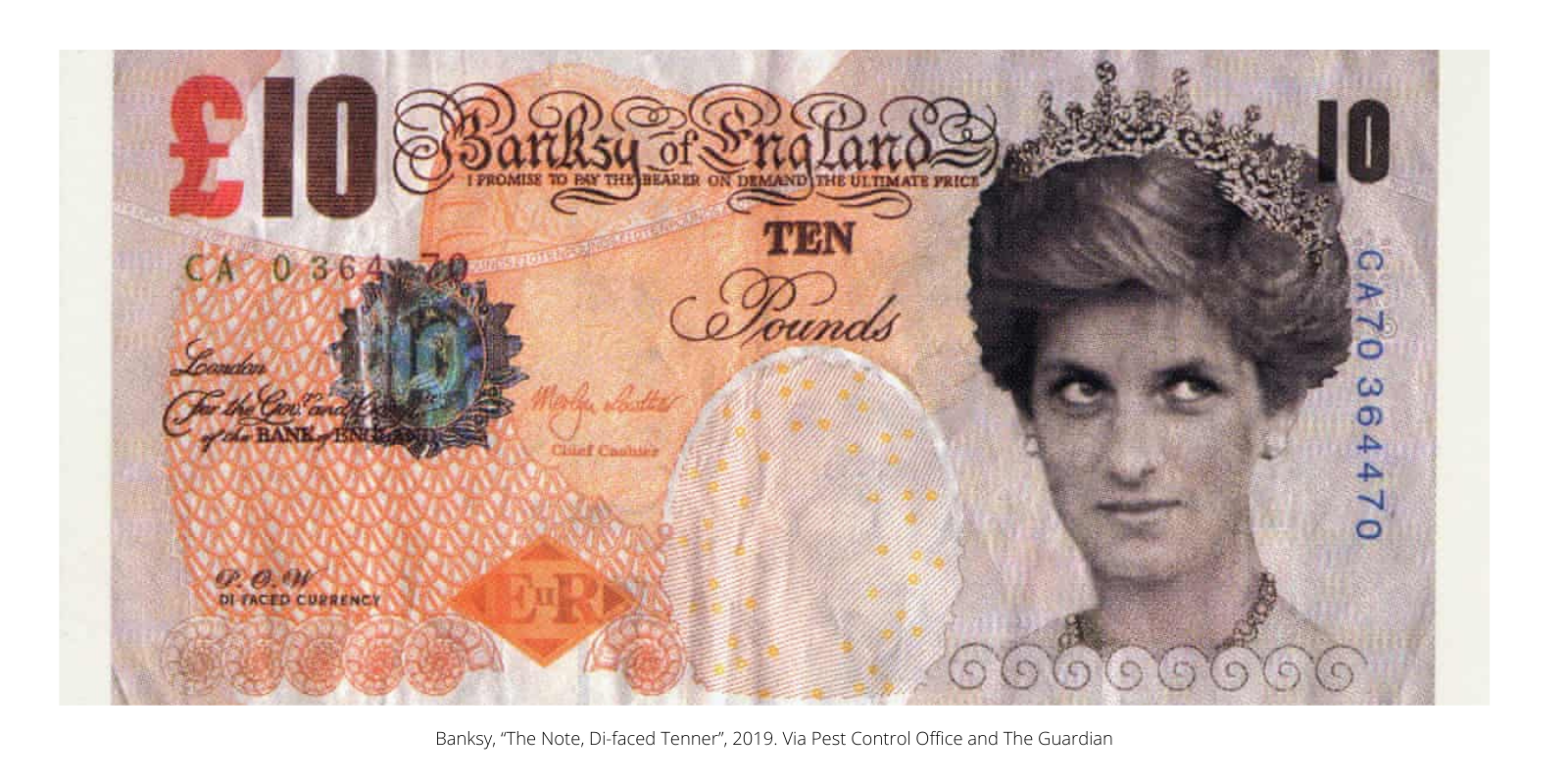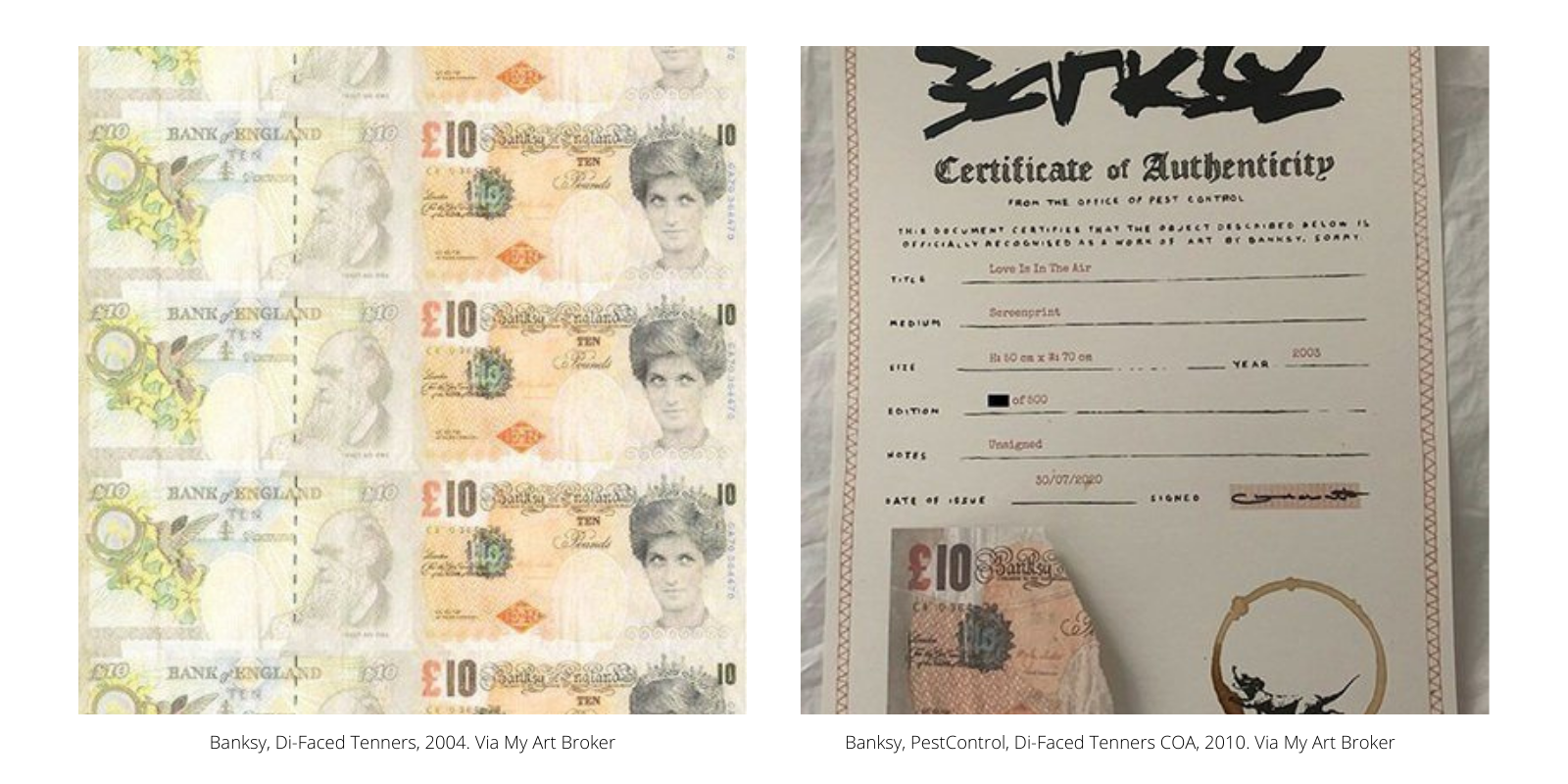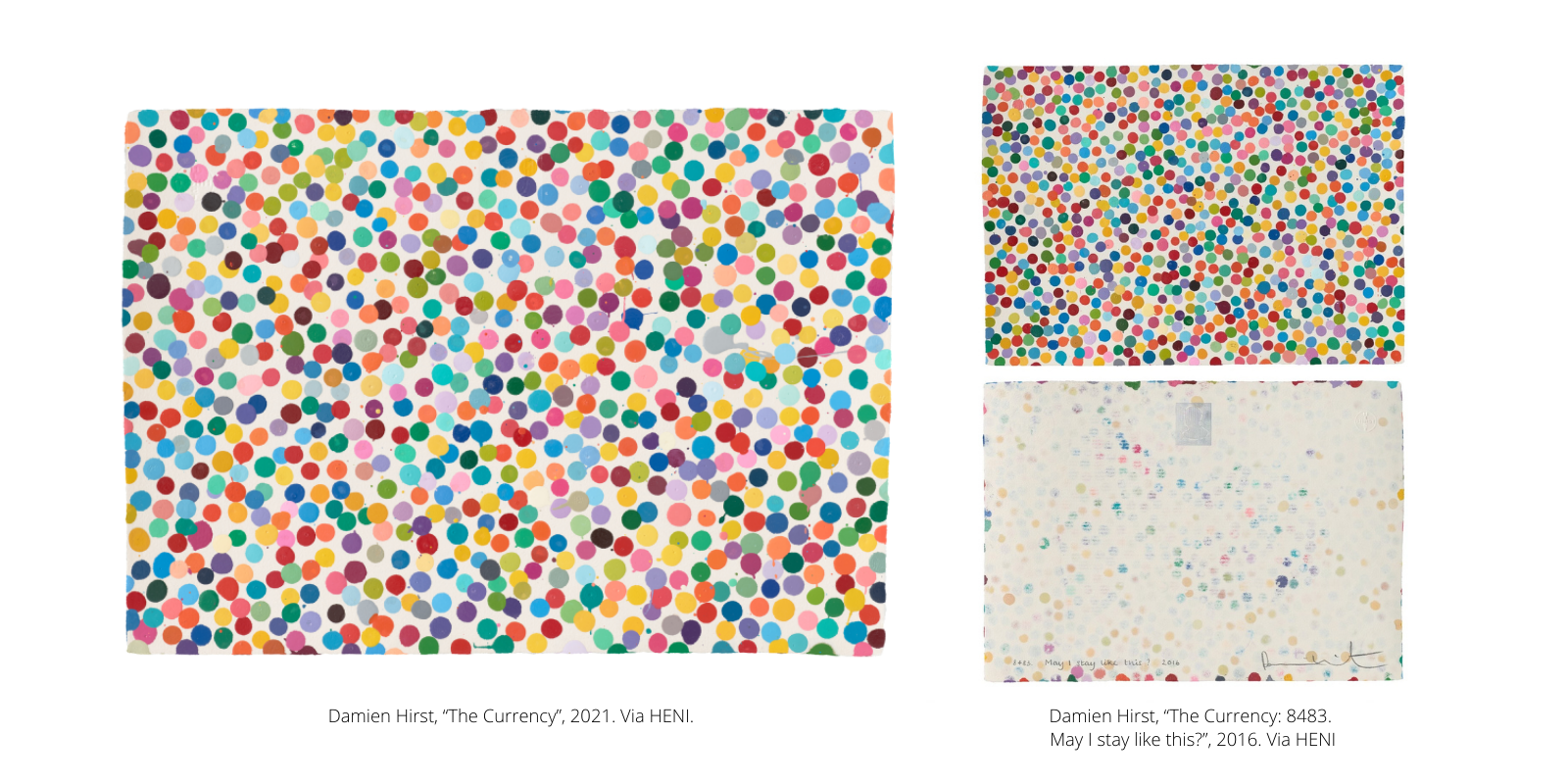Between Frames: Hirst vs. Banksy
Although money is essential to the Art world - as the ultimate price any buyer of art pays and therefore the financial transaction buying art implies - the inherent romanticising of Art makes talking about the financial side of things almost taboo. There is no getting away from the fact that Art is seen and used by many as an investment; it is bought, traded and flipped, yet there is still such a lack of transparency in the art market…why does it feel so uncomfortable to talk about Art as a commodity? Especially when so many people are using it in this way? We recently got hooked on this question after the latest Hirst release, ‘The Currency’ and could not stop comparing it with Banksy’s ‘Di-faced Tenner’ series. Both artists are using these works to shine a light on Art’s relationship with money in different but similar ways.
Hirst: Digital or Physical?
Damien Hirst’s latest project, ‘The Currency’, is an experiment which directly questions Art’s value, it’s relationship to commoditisation, and collectors’ motivations. The project consists of 10,000 NFTs (non-fungible tokens) which correspond to unique physical artworks. Each NFT can be traded in for their corresponding physical artwork, (a unique rendition of Hirst’s iconic spot painting, on a 20cm x 30cm piece of handmade paper). Though, you cannot have both. That’s right! Hirst is forcing the buyer to choose between keeping the digital NFT or the physical artwork itself.
This experiment will expose the ultimate character of the collector - Do they see Art as a commodity whose value can merely be transferred into an NFT, or do they believe the value is retained in the physicality of the traditional painting itself? We imagine it would be hard for anyone buying this work not to be swayed by the financial opportunities that could emerge amidst all this hype... but we are still inherently curious to see what the majority of collectors will opt for when they are forced to make this choice: digital or physical...which will win out? And what does this then say about the nature of collecting, and indeed Art itself?
Art as Currency: Hirst vs. Banksy
When discussing currency, there’s more to think about than just value. It also comes with some technicalities and standardisation that enable each ‘token’ to be unique whilst following one coherent format. If you think about it, each currency in the world has an anti-counterfeiting feature such as a hologram and watermark. So you may be asking yourself- ‘How can these Hirst paintings be considered currency at all when they lack all these anti-counterfeiting features?’ Hirst surely did not leave any space for these kinds of questions in this experiment- he has added several details to create a type of ‘hand-crafted currency’ for himself. As a result, not only does each painting contain a plethora of ‘rarities’ such as unique spot patterns, density and drips, but also they have other ‘currency-like’ details such as a watermark and a hologram of Hirst’s head.

Our next question is how much does hand-made versus machine-made affect our perceived value of something? What if Hirst's paintings were machine-made copies rather than hand-made?’
In Banksy’s series, ‘Di-faced Tenner’ (2004), Banksy used machines to print £1million worth of £10 notes where he replaced the portrait of Queen Elizabeth II for an image of Princess Diana. These notes are currently in the coin collection of British Museum which creates a finer line between what is art and what is currency. Though, as Hirst, Banksy added a few other details to these £10 notes that makes it a Bansky-signature artwork itself. Details such as “Banksy of England” instead of “Bank of England”; the unmissable statement “Trust No One” and a reference to one of Princess Diana’s quotes, “I promise to pay the bearer on demand the ultimate price”. Lastly and most impressively, these notes are all under COAs (Certificate of Authenticity) - Yes, 1 million artworks with their own COA! Impressive, right? The plethora of rarities explains why these ‘fake’ notes are being sold for over 2k at auctions now. Again, Banksy has left little to no room for anyone to question his ‘Di-faced Tenner’ as Fine Art.

Yet, we cannot stop questioning if these notes are artworks in the same way that Hirst’s hand-made works are? Are Hirst's more valuable as art because of its artistry? Or is this just just an absurd thought? One is machine made, the other hand-crafted; both allude to capital but none is actual cash. Traditionally speaking, you cannot use these ‘Di-faced Tenner’ notes as cash to buy food, for example- does that make it more of an artwork?
Both Hirst and Bansky, in these two particular series ’The Currency’ and ‘Di-Faced Tenner’, put money at the forefront of their Art. But focusing on the concept of money as being so central to the value of Art itself will undoubtedly continue to raise eyebrows. Vulgarising art as a commodity dilutes ideas of ‘pure artistry’, exposing the financial and monetary side of the art market.
So, is Art currency?
Although Hirst and Banksy make a not-so-subtle link between Art and currency through their works, the idea that Art is a type of capital is not new at all. People have been trading Art as currency for centuries! These artists have simply taken a concept as old as the merchant bartering systems, where goods (including Art) were exchanged on physical marketplaces, and made the line between Art and a fixed financial value even harder to distinguish.

Hirst and Banksy are certainly aware that their work now has inherent monetary value and therefore have chosen to actively play on that idea rather than shying away from it. Although Hirst’s ‘The Currency’ of Banksy's ‘Di-Faced Tenner’ may not be everyone’s cup of tea, the questions these experiments raise are definitely interesting to consider! Is treating Art like a commodity so explicitly, dangerous for the future of Art? Or is it simply acknowledging the unavoidable reality: that Art exists within a financial market?









